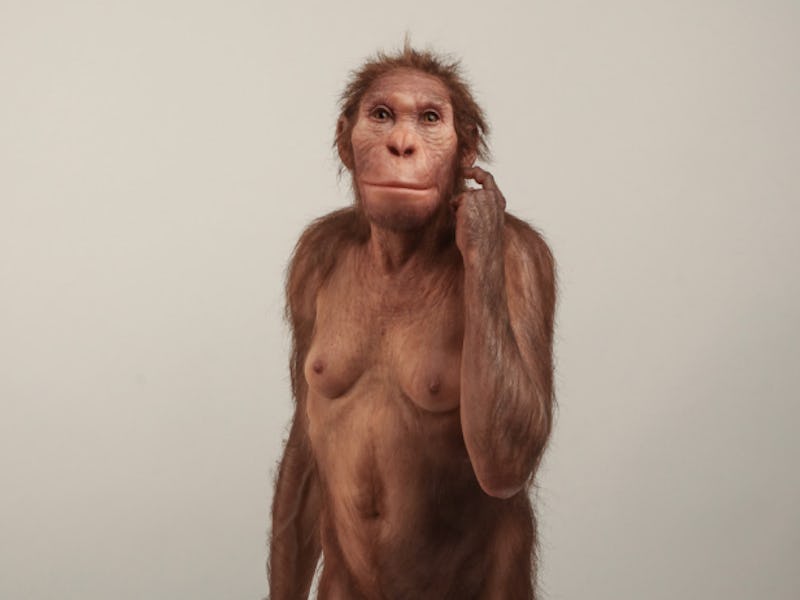In Hunt for Humanity's Earliest Ancestor, Scientists Rule Out a Top Contender
"I imagine there might be some though who will be skeptical -- as is always the case."

Debates about people are always spicy, but they’re especially so when the history of humanity is on the line. Scientists studying the origin of humans generally agree that the ancient hominins known as Australopithecus gave rise to Homo, and two particular species, Australopithecus sediba and Australopithecus afarensis, are top contenders for our earliest ancestors. A new Science Advances study released Wednesday shows that one species is far more likely than the other.
Fossils belonging to Australopithecus sediba were first found in 2008, leading some scientists to propose the species was the direct ancestor of Homo erectus. Others, however, have long argued that A. afarensis, the species that includes the famous “Lucy” skeleton, discovered in 1974, is the more likely ancestor to modern-day Homo species.
The University of Chicago researchers behind the new analysis don’t accept A. sediba as the direct ancestor of Homo. They argue that it’s statistically very unlikely that the hominin, which lived around 2 million years ago, could have given rise to our ancestors and that A. afarensis is the far more likely candidate.
Their argument centers on a timeline: The oldest known Homo fossil, a jawbone, is dated at 2.8 million years old, predating A. sediba by 800,000 years.
“There are a handful of researchers who believe A. sediba is the ancestor of Homo, but there have been very few decisive tests which have sought to reject this hypothesis,” lead author Andrew Du, Ph.D., tells Inverse.
The cranium of a juvenile skeleton belonging to Australopithecus sediba.
He said Wednesday that while “it is definitely possible for an ancestor’s fossil to predate a descendant’s by a large amount of time,” the probability of finding this chronological pattern is highly unlikely. Their models show that the probability is next to zero.
Du and co-author Zeresenay Almeseged, Ph.D. created a test to reject the A. sediba hypothesis by inputting chronological data into probability models. These models revealed that the likelihood of finding an ancestor fossil at least 800,000 years younger than a descendent’s fossil is about 0.09 percent on average — which isn’t great for team A. sediba.
They corroborated the results by looking through the scientific literature for examples of purported hominin ancestor-descendent species. Of the 28 examples they found, only one pair contained a fossil older than a proposed ancestor. This pair was separated by 100,000 years — less than the 800,000 years separating A. sediba and the earliest Homo.
A reconstruction of the head of an *Australopithecus afarensis.*
Given data on timing, geography, and morphology, Alemsegard and Du maintain that A. afarensis is the better candidate for a direct ancestor to members of the Homo genus — an opinion shared by other scientists who doubt A. sediba’s claim.
But the debate is far from settled. Steven Churchill, Ph.D., an anthropologist who was part of the team that first analyzed the A. sediba fossils, told Inverse in a previous interview that he believes the species represents the best candidate for an ancestor of “true humans.”
"I imagine there might be some though who will be skeptical — as is always the case."
While he has admitted that A. sediba may be too young to be directly ancestral to all members of genus Homo, its humanlike face, teeth, and body make it a better candidate than Lucy’s A. afarensis family.
“This is reflected in our choice of a specific name, sediba, which means ‘source’ or ‘wellspring’ in Sesotho,” Churchill said. “This interpretation hasn’t been universally accepted, because well, that’s the nature of science.”
Du reasons that it’s difficult for science to conclusively settle a debate, especially when the debate surrounds such a complex, nuanced question.
“I do think our study is very convincing, and I think most people in our field will be persuaded by the results,” Du says. “I imagine there might be some though who will be skeptical — as is always the case.”
Abstract:
Understanding the emergence of the genus Homo is a pressing problem in the study of human origins. Australopithecus sediba has recently been proposed as the ancestral species of Homo, although it postdates earliest Homo by 800,000 years. Here, we use probability models to demonstrate that observing an ancestor’s fossil horizon that is at least 800,000 years younger than the descendant’s fossil horizon is unlikely (about 0.09% on average). We corroborate these results by searching the literature and finding that within pairs of purported hominin ancestor–descendant species, in only one case did the first-discovered fossil in the ancestor postdate that from the descendant, and the age difference between these fossils was much less than the difference observed between A. sediba and earliest Homo. Together, these results suggest it is highly unlikely that A. sediba is ancestral to Homo, and the most viable candidate ancestral species remains Australopithecus afarensis.